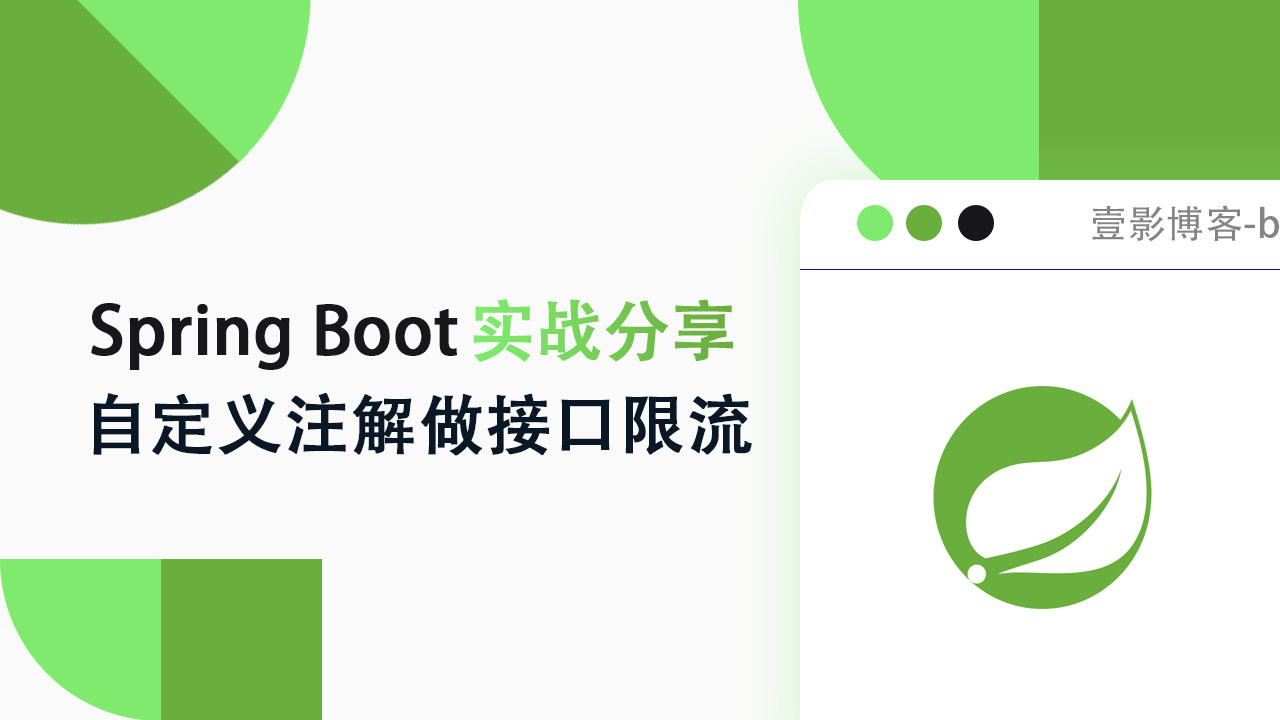
spring boot实战分享-自定义注解做接口限流
利用自定义注解做界面实现对于controller的接口访问限制 废话不多说直接看看最终的自定义注解长什么样
// 限制查询次数 每分钟只能查询10次
@AccessLimit(second = 60,max = 10)
@GetMapping("/getProjectList")
public R getProjectList(String codes) {
return R.data();
}
我们只需要在需要限流的controller上面加上注解 就能够实现对于接口请求访问的限制,那么具体如何编写这个注解呢?代码如下
首先我们需要先创建一个注解类 AccessLimit.java
import java.lang.annotation.*;
/**
* @program: carbon-offset
* @description: 用户限流注解
* @author: yyge
* @create: 2023-11-15 14:13
**/
@Documented
@Target(value = ElementType.METHOD) //可以注解在方法上面 用在controller层
@Retention(RetentionPolicy.RUNTIME)
public @interface AccessLimit {
// 这里只是注解 现在还需要写一个切面
int second() default 60; // 默认情况下 每1分钟 可以访问10次
int max() default 10; // 默认情况下 每1分钟 可以访问10次
}
然后我们还需要去编写一个切面类AccessLimitAspect.java
/**
* @program: carbon-offset
* @description: 用户限流 切面
* @author: yyf
* @create: 2023-11-15 14:17
**/
import com.chy.core.log.exception.ServiceException;
import com.chy.core.redis.cache.ChyRedis;
import com.chy.core.tool.utils.Func;
import com.chy.modules.auth.enums.I18nInfoEnum;
import lombok.AllArgsConstructor;
import lombok.extern.slf4j.Slf4j;
import org.aspectj.lang.ProceedingJoinPoint;
import org.aspectj.lang.annotation.Around;
import org.aspectj.lang.annotation.Aspect;
import org.aspectj.lang.annotation.Before;
import org.aspectj.lang.annotation.Pointcut;
import org.springframework.stereotype.Component;
import org.springframework.web.context.request.RequestContextHolder;
import org.springframework.web.context.request.ServletRequestAttributes;
import javax.servlet.http.HttpServletRequest;
import java.time.Duration;
import java.util.Objects;
@Aspect
@Slf4j
@Component
@AllArgsConstructor
public class AccessLimitAspect {
// 注入Redis服务 (redisTemplate)
private final ChyRedis chyRedis;
// 使用一个自定义的注解 定义为切点
@Pointcut("@annotation(com.chy.modules.co.aspect.AccessLimit)")
private void annotationPointCut() {
}
// 定义切面函数
@Around("annotationPointCut() && @annotation(accessLimit)")
public Object before(ProceedingJoinPoint joinPoint,com.chy.modules.co.aspect.AccessLimit accessLimit) throws Throwable {
// 获取客户端的IP地址
// 获取当前的HttpServletRequest对象
HttpServletRequest request = ((ServletRequestAttributes) RequestContextHolder.currentRequestAttributes()).getRequest();
// 初始化变量addr和clientIp
String addr = null;
String clientIp = null;
// 定义需要检查的请求头名称数组
String[] headerNames = {
"X-Real-IP",
"Client-Ip",
"Proxy-Client-IP",
"WL-Proxy-Client-IP",
"HTTP_CLIENT_IP"
};
for (String header : headerNames) {
String value = request.getHeader(header);
if (value != null && value.length() != 0 && !"unknown".equalsIgnoreCase(value)) {
clientIp = value;
break;
}
}
// 若clientIp依然为null,则使用getRemoteAddr()方法作为备选方案
if(clientIp == null){
addr = request.getHeader("x-forwarded-for");
if (addr==null){
addr = request.getRemoteAddr();
}
}else{
addr=clientIp;
}
//先获取一下方法名称 全路径
String class_name = joinPoint.getTarget().getClass().getName(); //获取注解所在类的类名
String method_name = joinPoint.getSignature().getName(); //获取注解所在类的方法名
String redisMark="limit:"+addr+":"+class_name+"."+method_name; //生成redis的标识 方便查询次数
// 现在是要根据ID去做标识
//判断注解是否开启限制-如果开启限制则从Redis中查询数据 查看登记的次数
Integer key = chyRedis.get(redisMark);
if(Func.isNull(key)){
long maxNumber= accessLimit.second();
chyRedis.setEx(String.valueOf(redisMark),1, Duration.ofSeconds(maxNumber));
}else{
// 如果max是10次 则第11次就会提示错误
if(key >= accessLimit.max()){
throw new ServiceException(I18nInfoEnum.SYSTEM_LIMIT_ERROR.getKey()); //错误提示
}else{
//获取剩余过期时间
Long ttl = chyRedis.ttl(redisMark);
//value值+1
key++;
//重新设置值以及过期时间
chyRedis.setEx(String.valueOf(redisMark),key, Duration.ofSeconds(ttl));
}
}
//返回并执行正常的controller 内的内容
return joinPoint.proceed();
}
}


发表评论